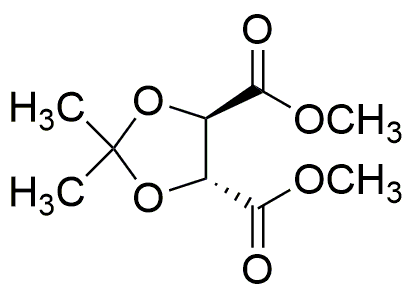Dimethyl (-)-2,3-O-isopropylidene-L-tartrate is widely utilized in research focused on:
- Chiral Synthesis: This compound serves as a chiral auxiliary in asymmetric synthesis, helping chemists create specific enantiomers that are crucial in pharmaceuticals.
- Pharmaceutical Development: It is used in the formulation of drugs, enhancing their efficacy and stability, particularly in the development of anti-cancer and anti-inflammatory medications.
- Biochemical Research: Researchers employ it in studies involving enzyme interactions and metabolic pathways, providing insights into biological processes and potential therapeutic targets.
- Food Industry: The compound can be utilized in the production of flavoring agents and food additives, contributing to the enhancement of taste profiles in various products.
- Polymer Chemistry: It is applied in the synthesis of biodegradable polymers, supporting the development of environmentally friendly materials for packaging and other applications.
General Information
Properties
Safety and Regulations
Applications
Dimethyl (-)-2,3-O-isopropylidene-L-tartrate is widely utilized in research focused on:
- Chiral Synthesis: This compound serves as a chiral auxiliary in asymmetric synthesis, helping chemists create specific enantiomers that are crucial in pharmaceuticals.
- Pharmaceutical Development: It is used in the formulation of drugs, enhancing their efficacy and stability, particularly in the development of anti-cancer and anti-inflammatory medications.
- Biochemical Research: Researchers employ it in studies involving enzyme interactions and metabolic pathways, providing insights into biological processes and potential therapeutic targets.
- Food Industry: The compound can be utilized in the production of flavoring agents and food additives, contributing to the enhancement of taste profiles in various products.
- Polymer Chemistry: It is applied in the synthesis of biodegradable polymers, supporting the development of environmentally friendly materials for packaging and other applications.
Documents
Safety Data Sheets (SDS)
The SDS provides comprehensive safety information on handling, storage, and disposal of the product.
Product Specification (PS)
The PS provides a comprehensive breakdown of the product’s properties, including chemical composition, physical state, purity, and storage requirements. It also details acceptable quality ranges and the product's intended applications.
Certificates of Analysis (COA)
Search for Certificates of Analysis (COA) by entering the products Lot Number. Lot and Batch Numbers can be found on a product’s label following the words ‘Lot’ or ‘Batch’.
*Catalog Number
*Lot Number
Certificates Of Origin (COO)
This COO confirms the country where the product was manufactured, and also details the materials and components used in it and whether it is derived from natural, synthetic, or other specific sources. This certificate may be required for customs, trade, and regulatory compliance.
*Catalog Number
*Lot Number
Safety Data Sheets (SDS)
The SDS provides comprehensive safety information on handling, storage, and disposal of the product.
DownloadProduct Specification (PS)
The PS provides a comprehensive breakdown of the product’s properties, including chemical composition, physical state, purity, and storage requirements. It also details acceptable quality ranges and the product's intended applications.
DownloadCertificates of Analysis (COA)
Search for Certificates of Analysis (COA) by entering the products Lot Number. Lot and Batch Numbers can be found on a product’s label following the words ‘Lot’ or ‘Batch’.
*Catalog Number
*Lot Number
Certificates Of Origin (COO)
This COO confirms the country where the product was manufactured, and also details the materials and components used in it and whether it is derived from natural, synthetic, or other specific sources. This certificate may be required for customs, trade, and regulatory compliance.


